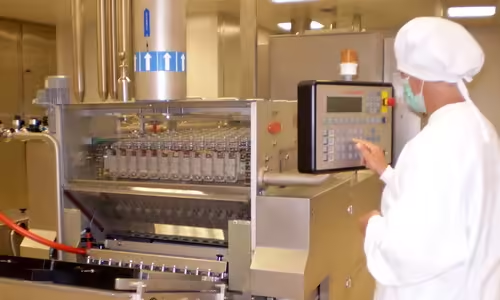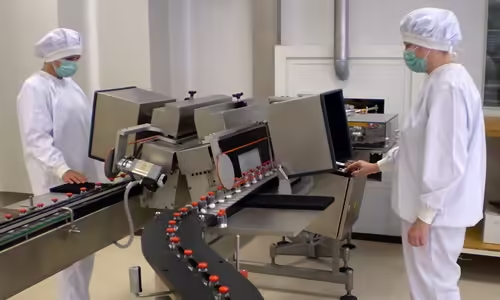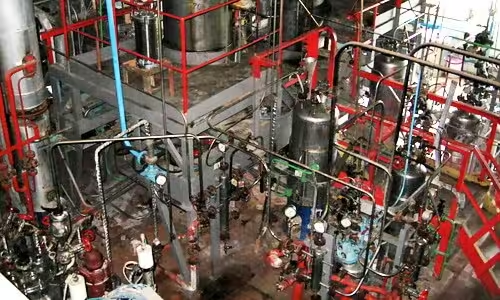history of plant

The beginning of the history of the plant of microbiological synthesis preparations «Enzim» was laid by the Decree of the Central Committee of the CPSU and the Cabinet of Ministers of the USSR No. 664 of August 8, 1970, on the construction in the city of Ladyzhyn of a plant for the production of enzymatic products (enzymes) through the microbiological synthesis for the needs of various sectors of the national economy.
Commissioning of the 1st stage of the plant was done in January 1971. Commissioning of the 2nd stage was done in December 1981. The «Enzim» plant was a multiple winner in social competitions of the region and Glavmicrobioprom at RM of the USSR.
The need for the construction of such production was due to the rapid growth of consumption of detergents by the population, the progressive development of various sectors of the national economy, in particular alcohol and food industries, as well as the introduction of new progressive methods of animals feeding using enzymes, which significantly increased the economic performance in the production of meat and other components.
The main production purpose of the plant (at the initial stage) was the production of enzymes for additives (supplements) to washing powders in the manufacture of synthetic detergents. Production capacity of this type of product was to 3800 commodity tons per year. Only the production of alkaline protease covered 50-60% of the needs of the entire Soviet Union in detergents with supplements.
Along with the development of alkaline protease production, more than 19 new technologies of other preparations of microbiological synthesis of a wide range of applications were put into production. So the total capacity of the plant was more than 4500 commodity tons of various enzymes and other biologically active preparations. The company employed over 2500 people with high educational qualifications. In connection with the specifics of work with microorganisms the number of ETW (engineering and technical workers) was up to 300 people at the plant, and more than 100 engineer-microbiologists, technologists, biochemists worked in the production of enzymes and laboratories.

In the first half of 1984, for the achievement of high indicators in social competition «For increasing the efficiency of production and quality of work between industrial enterprises of the region», the plant was awarded 1st place with the handover of the movable Red Flag of the Vinnytsia Regional Committee of the Communist Party of Ukraine, the Executive Committee of the Regional Council of People's Deputies, the Regional Council trade unions and regional committees of LKSM of Ukraine.
For successful implementation of planned tasks and socialist commitments in the III quarter of 1984 the plant was awarded 1 place with the handover of the Red Flag of the Glavmikrobioprom and the Central Committee of Trade Unions of workers of the chemical and petrochemical industry.
In the former USSR, Enzim was the largest producer of enzymatic preparations. In the entire space of the former USSR there are no similar to “Enzim” enterprises with great practical experience in the field of microbial synthesis. The enterprise is staffed with specialists of the highest class in the field of biotechnology of microbial synthesis.
The main task of our activity is the production of high-quality, innovative and safe bioproducts, the creation of a reputation of a reliable and stable partner both in the domestic and international markets.
Today we are ready to provide the needs of Ukrainian and foreign consumers in highly effective, modern products obtained by microbial synthesis.
The preparations we produce are registered in the established order and are provided with all necessary permits for production and sale.
We are always ready for cooperation. You will receive answers and recommendations for all of your questions regarding the products manufactured by us. We are ready to hear your opinion about them, whatever it may be.
For all the preparations that we release, our specialists provide consulting services. Where necessary, practical assistance is provided to evaluate the effectiveness of the use of preparations.
technology

Microbiological synthesis is the industrial way of obtaining chemical compounds and products (for example, feed yeast), which is carried out thanks to the vital activity of microbial cells. Sometimes microbiological synthesis also includes industrial processes based on the use of immobilized cells.
Some products of microbiological synthesis, for example, baker's yeast, have long been used by humans, but the widespread use of microbiological synthesis began in the 40-50s of the 20th century in connection with the development of penicillin production. A new branch of national economy - the microbiological industry appeared also during this time.
In microbiological synthesis complex substances are formed from simple ones as a result of functioning of enzymatic systems of a microbial cell. By this it is different from fermentation as a result of which various metabolic products of microorganisms (alcohols, organic acids, etc.) are formed, but mainly as a result of the enzymatic degradation of organic matters.
Microbiological synthesis uses the ability of some organisms to reproduce at a high speed (isolated bacteria and yeast, which biomass is increased 500 times faster than the most productive crops) and to "super synthesis" - excessive formation of metabolic products (amino acids, vitamins, etc.) that exceeds the needs of the microbial cells.
For the microbiological synthesis of organic compounds, the cheapest sources of nitrogen (for example, nitrates or ammonium salts) and carbon (for example, carbohydrates, organic acids, alcohols, fats, hydrocarbons, including gaseous) are used as raw materials. Microbiological synthesis includes the range of successive stages. The main of them are the preparation of the necessary culture of the microorganism - the producer, the producer cultivation, cultivating the producer in the given conditions during which microbiological synthesis is carried out (this stage is often called fermentation), filtration and separation of biomass, selection and purification of the required product (if necessary), drying.
Fermentation is carried out in special reactors (fermenters) equipped with devices for mixing the medium and supply of sterile air. Process management can be done by using electronics. It is most convenient to carry out fermentation in a continuous manner - with constant feeding of the medium and the removal of products of microbiological synthesis. In such a way feed yeast are produced. However, most of the metabolites are obtained periodically - with the removal of the product at the end of the process.
The most important products of microbiological synthesis:
Antibiotics. Most antibiotics are accumulated outside the cells of the microorganism-producer, which are mainly actinomycetes, some fungi and bacteria (mainly their mutant forms). Antibiotics, which are used predominantly in medicine, undergo the high degree of purification. Antibiotics for the treatment of farm animals have specific activity in relation to the most common diseases, for example, helminthiasis, coccidiosis and others. For adding to the feed the concentrate of the medium is usually produced after growing in it by the producer, sometimes together with biomass containing a significant amount of other products of the producer“s metabolism, incl. vitamins, amino acids. nucleotides, etc.
Amino acids. The essential advantage of the microbiological synthesis of amino acids is the ability to obtain them in the form of natural isomers (L-forms). The amino acid producers are mainly mutants, devoided of a number of enzyme systems, which results in the super synthesis of the desired product. Commonly the bacteria belonging to the genus Brevibacterium are used. Lysine and glutamic acid have the highest rate among the amino acids produced by the world industry. Mutants of microorganisms capable for super synthesis of all coded amino acids have been obtained.
Nucleoside phosphates. The development of microbiological synthesis of nucleotides (inosinic, guanilic and other acids) is associated with the prospects of obtaining of artificial food, where they are used as flavoring additives. When introducing into the cultivation medium the microorganisms of metabolic precursors of synthesis products, practically all known nucleoside phosphates can be obtained, including ATF. Accumulation of nucleoside phosphates occurs predominantly outside the cells of microorganisms.
Vitamins, provitamins, coenzymes.es. By the method of microbiological synthesis mainly vitamin B12 and its coenzyme form are produced. The producers in this process are propionic acid bacteria. For receiving of the feed concentrates containing vitamin B12 on the waste of the fermentation industry (alcohol-free, acetone-butyl bard, etc.) the complex of methanogenic bacteria are applied. The methods for producing of vitamin B2, p-carotene and yeast enriched with ergosterol are developed. Using appropriate metabolic precursors the microbiological synthesis of nicotinamide coenzymes, for example nicotinamide, is also possible.
Alkaloids. Fungi of the genus horns (Claviceps) are the producers of ergoalkaloids. The basis of the molecules structure there is heterocycle ergolin. Some of these alkaloids (e.g., ergometrine and ergotamine) are used as uterine products. Numerous producers of other alkaloids are also described.

Gibberellins. Their microbiological synthesis is carried out in the cultivation of fungi belonging to the class of ascomycetes, such as Gibberella fujikuroi. The gibberellins are separated from a culture liquid filtrate. By chemical nature, all of them are tetracyclic carboxylic acids, which are related to diterpens.
Enzymes. Producers of enzymes are numerous representatives of microscopic fungi, some actinomycetes, and other bacteria. The technology of obtaining enzyme preparations is simplified if the enzyme is produced in the nutrient medium. At the allocation of intracellular enzymes it is necessary at first to destroy the cells of microorganisms. For research, analytical purposes, etc., enzymes are usually obtained in the form of homogeneous (individual) proteins. At industrial processing of agricultural raw materials in the food industry the complex of enzyme preparations is sometimes used. So, in the processing of plant material the enzyme complex should contain cellulases, hemicellulases, pectinases, proteases and some other enzymes. One of the most important enzymes, obtained by microbiological synthesis is glucose isomerase that catalyzes the isomerization of glucose into fructose. The received glucose-fructose syrup is used in the food industry instead of sucrose.
Protein-vitamin preparations. Microbial biomass as a source of protein attracts special attention. The production of such biomass on cheap raw materials is considered as one of the means to eliminate increasing protein deficiency in animal nutrition. Industrial methods of microbial feed yeast synthesis were developed most intensively. Such yeasts are used in the form of dry biomass as a source of protein and vitamins in livestock production.
Among the products of microbiological synthesis there are also some plant protection products, such as bacterial entomopathogenic preparations causing the death of harmful insects and preventing their mass reproduction.
A special case of microbiological synthesis is the microbiological transformation of organic compounds. It is carried out due to the high activity of specific enzyme systems of microorganisms that catalyze the transformation of a substance without changing its basic structure. The most studied transformation of steroid compounds is, for example, their dehydrogenation, deacetylation and hydroxylation in strictly defined positions. Due to the wide selection of microorganisms (carriers of specific enzyme systems), the method of microbiological transformation is becoming more widespread.











